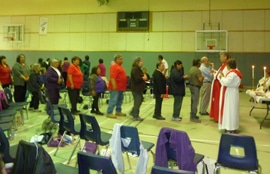Diocese of Moosonee combines Gospel vision with Cree culture in special weekend gathering
The Rev. Dr. Marilyn van Duffelen is not afraid of a challenge. The Priest-in-charge at St. Mark’s in Eastmain, QC has seen her community’s struggle to heal from past wounds—and felt called to action.

This past August a healing gathering was held in Eastmain in the Diocese of Moosonee. The Cree Nation of Eastmain is the smallest of the Cree communities around James Bay. “There’s around 900 people here, half of them under the age of 16,” says van Duffelen. The 3-day event, which culminated in a Eucharist with anointing with healing oil, featured Gospel singing, craft exchanges, traditional food, a surprise concert and, most central to the event, healing circles.
Past diocesan healing events had featured more of a workshop-style format; however, van Duffelen had a different idea. “I went to the TRC [Truth and Reconciliation Commission] conference in Montreal. And there, I didn’t see healing happening in workshops—I saw healing happening in small circles formed in the retreat rooms.”
The use of circles is a traditional Cree way of meeting in which a member of the circle holds a ceremonial feather (or other special object) while speaking–and no one interrupts or rushes the one who shares. At Eastmain, each of the gathering’s circles had a facilitator, who opened the session by sharing a personal story around the topic, and a designated support person available in case a speaker became overwhelmed and needed to leave the circle for more private listening or prayer. The support person would then help the speaker rejoin the circle.
Circle topics included: Forgiveness, Broken Family Relationships, Parenting Issues, Residential School Healing and Healing our Communities. At least 2 hours were allotted for each circle—with many going well past that limit—and most of the facilitators were local people or others with Cree backgrounds, including Bishop Tom Corston, Eastmain Band Councilor Kenneth Gilpin, and Irene Barbeau, who hosted her circles in Cree.
Over the weekend, many took what van Duffelen calls “those baby steps;” they “began their healing journey.” At the final Eucharist, van Duffelen describes, “We practically doubled our showing, and they all came to the Eucharist. And then everyone lined up to be anointed with healing oil. So it made an enormous difference that the people were comfortable enough in a Church setting, in the Eucharist, to own that.”
This unity was particularly poignant for van Duffelen, who facilitated a healing circle called “Christian and Indigenous Spirituality Walking Together.” She explains, “You know, within the community of Eastmain, there’s actual divisiveness between the longstanding Christian practicing people and the Christians who are now exploring their Indigenous identity through the practice of traditional ceremonies.” As a facilitator, van Duffelen told her personal story of the “hurt that is caused by that divisiveness.”
She reflects on how people work through this conflict within themselves: “Some people do, without any difficulties….If you’re comfortable in your faith, then you can be a Cree person and a faithful person, there’s no dichotomy there.”
But others are working towards integrating their Christian and Cree identities. This problem has been “compounded by the stripping away of cultural identity, caused by the residential school experience—stripping away their language, stripping away their ability to belong to the communities from which they came.”
When van Duffelen considers the healing that needs to happen around this issue, she takes the long view—the long view back. “We have to remember the Indigenous people here around James Bay, which is all that I can really speak of, were Christian Cree people for more than a hundred years before the residential school experience. So they had no difficulties being Christian Cree people. But when the Christian white church then strips away their Cree-ness, we’re now in the fallout of that act.”
So there’s still a long way to go. But van Duffelen is thrilled with the outcome of the event—at any one time 60 to 100 people were in attendance. In addition, the costs came in well under budget—a surplus van Duffelen hopes will be set aside for future gatherings since, she says, “the need is great.” But just as inspiring is the community’s growing commitment to healing—shown particularly in the enormous amount of unsolicited hands-on help from the band and the participation of band leaders and social services workers.
Thinking back, van Duffelen describes a moment between her and the band’s Chief: “At one point, the chief was there, and we caught eyes, and I put up my thumb, and he put up his thumb, an exchange of ‘This is good.’ And later on as we passed each other he said, ‘This is a beginning.’ So to me, I know it was the right thing. Everything we did was the right thing.”
Funding for Eastmain’s healing gathering came from the Council of the North, the Anglican Foundation, the Diocese of Moosonee and local sponsors.
Sharon Dewey Hetke
Council of the North Communications
Interested in keeping up-to-date on news, opinion, events and resources from the Anglican Church of Canada? Sign up for our email alerts .
